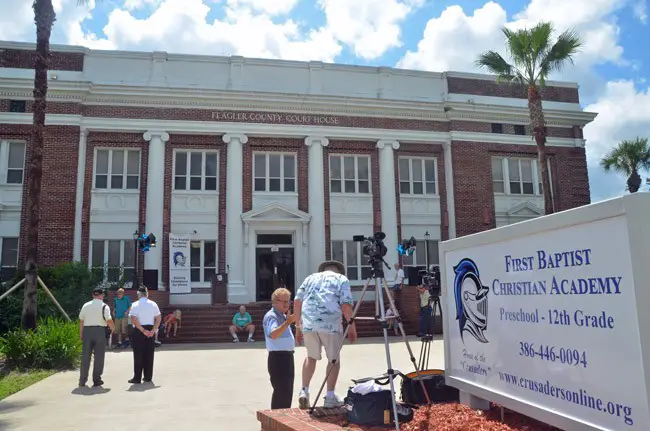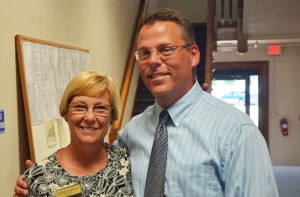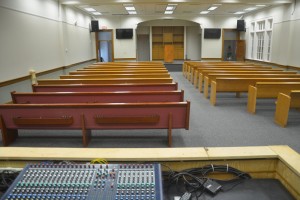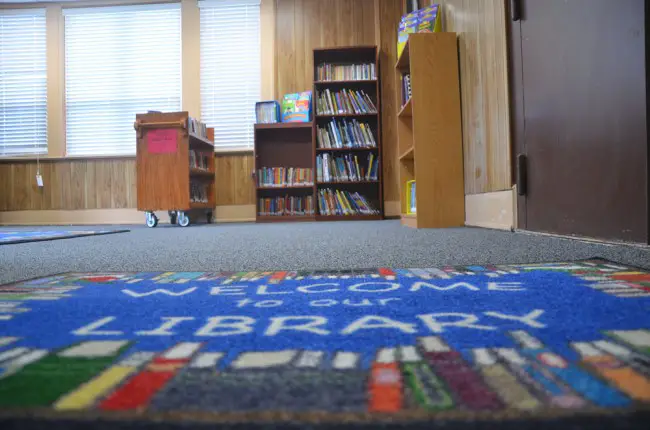
There wasn’t much hope for the old Flagler County Courthouse when the county commission appointed one more committee to figure out what to do with the thing. The building had been on the verge of being used as a sheriff’s headquarters, then not, then as a city hall for Bunnell, then not, then on the verge of being demolished if the county couldn’t find a tenant. The county wasn’t willing to keep paying the $70,000 a year or more it took just to mothball the 50,000 square foot, nearly centenarian building. Nor, at the time, had commissioners talked of investing more money in it to make it more appealing to tenants.
But in an unexpected turnaround, the committee found a tenant: First Baptist Christian Academy of Palm Coast. Then the county found $375,000 it could use to renovate the building (money taken out of the county’s share of a local sales surtax), crafted as an interest-free, 30-year loan to the school. The two sides signed the deal in February. The church backing the school poured in another $650,000. The building was made over.
Today, under an unforgiving noon sun and three days from the first day of school, the school re-baptized as First Baptist Christian Academy hosted a ribbon-cutting on what used to be the courthouse steps, ensuring that the building would not only remain a defining part of Bunnell’s identity, but turning it into a viable part of the town’s economy again. The school opens Monday with a 291 students in kindergarten through 12th grade, a total staff of 53—40 of them full-timers, and 32 of them teachers.
The private school, Pastor Kevin Lautar said, plans to grow to 500 students now that it has the room to do so: 33 classrooms, most double the size of the 20 classrooms the school had at its former location on Palm Coast Parkway. “The school kind of grew up,” Lautar said. “We were doing school in a church building. And now we have the opportunity to do school in a school building.” (Tuition is $5,000 a year per student, whatever the grade.)
The county still owns the building. First Baptist is paying the county $3,000 a month in rent, fees and loan pay-back for the first two years and four months. Rent will then go up to $6,000 a month.
“This is just a tremendous project, it’s great for the local economy of Bunnell, it’s great for our county, investments have been made,” County Administrator Craig Coffey said, standing next to Bunnell Mayor Catherine Robinson as throngs of people who’d turned out for the ribbon-cutting and open house walked through what used to be the main entrance to the old courthouse.

Much of the ceremony was framed in prayer and thanks to God, but also to the cooperation of the county and its work crews (though the financial generosity of the county and its taxpayers was not mentioned). Across the street, standing on the porch of Holden House, the historical house and home of the Flagler County Historical Society, Sisco and Gloria Deen watched the ceremony unfold with some relief despite the oppressive heat. “It’s a wonderful repurposing of the building, I think,” Sisco said. “I have always been afraid of the movement to tear it down. And I don’t have to chain myself to the flagpole.”
“Or the front door,” Gloria said.
“To go in today and it’s all fresh, new, smells good, teachers are dedicated,” Sisco said, describing those repainted, waxed, spotless interiors that let the eye glide with pleasure over decorated walls and newly built rooms where, just a few months ago, there were vast empty spaces and a look of arrested decay. “As a matter of fact the entire faculty has been here and discussed with me,” Sisco continued, “they wanted to see what we have here so they can bring the students. This is a good field trip, across the street.” Just as he said that, the crowd across the street cheered the cutting of the ribbon, not to mention the end of the ceremony so the crowd could file back into the cool interiors.

Mary Ann Clark, president of the historical society and a member of the last and previous courthouse committees, declared herself satisfied with today’s results. “It’s as I envisioned it,” she said, “and I’m just so happy. It’s so great for the city of Bunnell, the county, the church. It really was a perfect solution, and our county officials did a good job.”
Inside, the old portion of the courthouse, built in the 1920s and still reflective of old-style architecture, was converted into the school’s administration. The classrooms are in what used to be called the courthouse annex, a 34,000 square foot addition dating back to the early 1980s. The only surprise during the renovation, Laurat, the pastor, said, had to do with the boundaries of the parking lot, which hazed from county property to Bunnell city property. That’s been worked out with a fence. The building itself yielded no structural surprises, though it retains some of its immovable features, such as the big vault that used to be in the clerk of court’s office. John Winston, the leader of the districts mentor program, joked with a student as he passed by the vault that it would be the detention area.
It’s not clear what’s been made of the old jail holding cells that neighbored the courtrooms upstairs, but one courtroom was transformed into a chapel and meeting room, preserving the old pews—a room that would be made available to community meetings as well, Lautar said. The renovation includes a kitchen that could eventually serve hot meals to students, but not this year.
The school’s growth is part of the broader picture of private and charter schools slowly eroding the base of the public school district’s population, which hasn’t grown in five years, though charter, private and homeschool enrollment has. Moving away from the church building in Palm Coast may only increase the appeal of the school to people who don’t necessarily identify with its church, Lautar said. About 60 to 75 percent of students are from a faith background, he said.
“Many of the people who came to us,” Lautar said, “it was because of the education choice, not because of the church. Moving from palm Coast to Bunnell I believe puts us in a better position to really maximize the potential around us, puts us in the center of the community, north, south, east and west, and I think it’s going to be beneficial for us moving forward.”
![]()






























DwFerg says
Good outcome for all parties concerned. Great for Bunnell’s Econ Dev’l. Congratulations on solving a problem with a solution that keeps on giving !!! Rare these days, that everyone seems overjoyed with no opposition.
Layla says
Awesome! Really glad to see this historic building put to good use.
Nice Real Nice says
How Beautiful. What a wonderful transformation.
Gia says
Bravo. Kids have a much better education & discipline in a private school.
Jim WjamjAmes weames whim w says
Judge Deen would have been very proud